Chirk Castle and Gardens
|
Chirk Castle © Crown copyright (2013) Visit Wales
Chirk Castle is a 700 year old marcher fortress, which commands fine views over the surrounding countryside. It was built in the late 13th century by Roger Mortimer, Justice of North Wales for Edward 1. The castle was sold for 5,000 UK pounds to Sir Thomas Myddelton in 1595 and his descendants continue to live in part of the castle today Chirk Castle Entrance Gates and Lodge The magnificent iron gates are dated 1719 and bear the coat-of-arms of the Myddelton family of Chirk Castle. They are the work of the Davies Brothers, Robert and John of Croesfoel Forge, near Bersham, Wrexham and were erected between 1719 and 1721.
The original gates were intended to be located at the end of the drive from Chirk Castle gateway. It appears however, from a painting by Peter Tillemans of 1720, and engravings by Badeslade 1735 and Buck 1745 that the gates were positioned between flanking walls and screens to form a forecourt to the entrance to the Castle. William Emes, the landscape architect (who had designed gardens at the Old Rectory, Hawarden and improved the garden at Erddig, nr. Wrexham) produced a landscape design for the parkland and in 1771 the New Hall Lodge was built and the gates were moved alongside. In 1888 the gates were moved for a third time to their present position at Llwyn y Cil and the pallisades on either side were restored to their former state.
The coat-of-arms of the Myddelton family is the crowning point of the design over the overthrow of the gates. This incorporates the red "bloody" hand, of the Myddelton family, the three wolves heads and an eagles head. These features are then incorporated further into the design features; eagles heads springing from acanthus scrolls in each of the gates. The Red Hand of Chirk There are interesting myths or legends about the origin of the red hand in the Myddelton coat-of-arms. One story tells of a dispute which arose between two youths of the family in the distant past, over inheritance of the castle.
Another version of this story tells that they swam across the castle lake, and the first hand to touch the far shore was cut off. The second legend says that the red hand was put as a curse on the Myddelton family. It was said that the curse would only be removed if a prisoner succeeded in surviving imprisonment for 10 years in the Chirk Castle dungeons. The red hand still survives as part of the Myddelton coat-of-arms, proving legend says, that no one in history was able to live longer than 10 years in the terrible conditions of imprisonment at Chirk Castle. Another version of this story says that if a prisoner could stay alive for 12 years (without cutting his nails) he would inherit the Castle. A further story tells that during a battle led by one of the early Myddeltons, who was dressed in a white tunic, he was badly injured. He placed his blood-covered hand on his tunic and left the imprint of the bloody hand which then became his heraldic symbol. The Lodge is in the same architectural style as buildings seen in Chirk on Church Street and Station Avenue. The style is neo-tudor, often referred to as Old English and was built in 1888. see St. Mary's Church for more information on Chirk Castle and the Myddelton Family |
|
| Click on the town name below to visit other areas of Wales or Here for Map | ||||||
| Aberaeron | Aberdovey | Abergavenny | Aberystwyth | Amlwch | Bala | Barmouth |
| Beaumaris | Beddgelert | Betws-y-Coed | Brecon | Builth Wells | Caernarfon | Caldey Island |
| Cardiff | Cardigan | Carmarthen |  |
Chepstow | Chirk | Colwyn Bay |
| Conwy | Crickhowell | Denbigh | Fishguard | Flintshire | Harlech | |
| Haverfordwest | Holyhead | Llanberis | Llandrindod | Llandudno | Llangollen | |
| Machynlleth | Newport | Newtown | Porthcawl | Porthmadog | Pwllheli | Rhayader |
| Rhyl | Ruabon | Ruthin | Saundersfoot | St Asaph | St Davids | Swansea |
| Tenby | Welshpool | Wrexham | Photos | Old Photos | Chester | Oswestry |
Copyright © Mark Redfern 1998 -


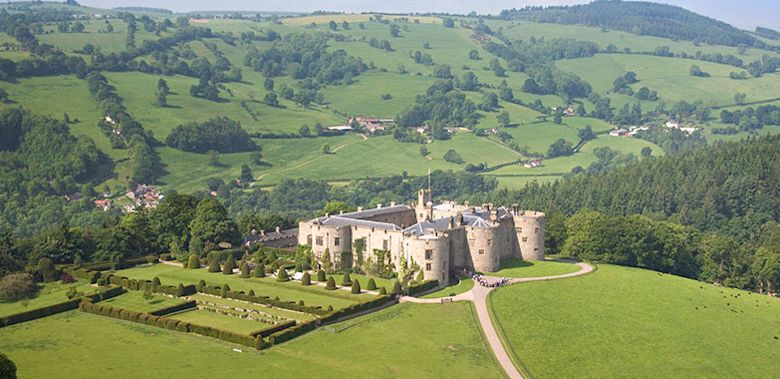
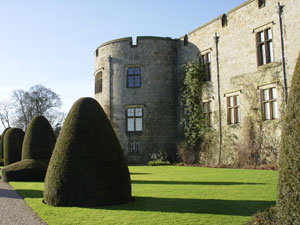 Chirk Castle, Chirk,
LL14 5AF, Wales, UK. Telephone:- +44 1691 777701
Chirk Castle, Chirk,
LL14 5AF, Wales, UK. Telephone:- +44 1691 777701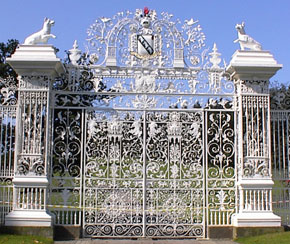 Sir
Richard Myddelton commissioned the Davies Brothers to make the gates in
January 1711 - 12 and they were paid 2 shillings a day to begin with, iron
being made available from Sir Richard's nearby Pont-y-Blew Forge.
Sir
Richard Myddelton commissioned the Davies Brothers to make the gates in
January 1711 - 12 and they were paid 2 shillings a day to begin with, iron
being made available from Sir Richard's nearby Pont-y-Blew Forge.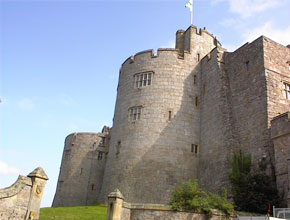 The
gates are overwhelming in their size and baroque detail and their
impressive barbaric splendour appears as too strong a statement for their
present position as entrance gates to the parkland. This is explained,
however, when one appreciates that they were developed as forecourt gates
to the Castle where they were read against its foreboding frontal towers.
The
gates are overwhelming in their size and baroque detail and their
impressive barbaric splendour appears as too strong a statement for their
present position as entrance gates to the parkland. This is explained,
however, when one appreciates that they were developed as forecourt gates
to the Castle where they were read against its foreboding frontal towers.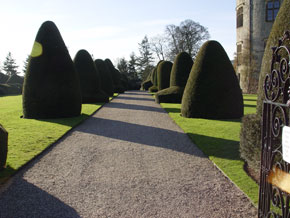 To
settle the dispute it was agreed that the two youths would run a race, to
finish with the winner touching the Castle gates. It is said that the
first youth to reach out to the gate at the finishing line was deprived of
victory by a supporter of his adversary, who drew his sword and cut off
the youth's outstretched hand - thus the "bloody" hand.
To
settle the dispute it was agreed that the two youths would run a race, to
finish with the winner touching the Castle gates. It is said that the
first youth to reach out to the gate at the finishing line was deprived of
victory by a supporter of his adversary, who drew his sword and cut off
the youth's outstretched hand - thus the "bloody" hand.